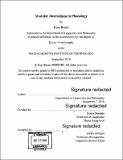Modular interactions in phonology
Author(s)
Rasin, Ezer.
Download1108654658-MIT.pdf (8.928Mb)
Other Contributors
Massachusetts Institute of Technology. Department of Linguistics and Philosophy.
Advisor
Donca Steriade.
Terms of use
Metadata
Show full item recordAbstract
This thesis makes two separate claims about the architecture of phonology: (1) The computation of stress takes place in a distinct cognitive module from segmental phonology. This module is informationally encapsulated from segmental features. (2) Phonological generalizations over underlying representations can be captured in the lexicon. The claim in (1) suggests a departure from a consensus view in generative phonology since the 1950's. According to this view, multiple phonological computations, including the computation of word stress and segmental processes, are carried out in a single cognitive module known as phonology. In Chapter 1 I challenge this view in two steps. I first argue for a new phonological universal based on the stress patterns of around 400 languages: (3) STREss-ENCAPSULATION UNIVERSAL: the distribution of stress is never directly conditioned by segmental features. After reanalyzing reported counterexamples to the universal, I argue for an account of the universal in terms of a modular decomposition of phonology along the lines of (1). The claim in (2) suggests a return to the architecture of early generative phonology, in which phonological generalizations could be captured in the lexicon (using constraints on underlying representations) as well as in the mapping from underlying representations to surface forms. Most recent work in phonology has abandoned that architecture, taking the lexicon to be merely a storage place for lexical items. Chapter 2, written jointly with Roni Katzir, presents an argument for constraints on underlying representations from learnability. In Chapter 3 I develop a new theory of blocking in non-derived environments, a phenomenon that has posed a long-standing puzzle for phonological theory since the 1970's. I argue that the new theory, which relies on constraints on underlying representations, offers a better account of the phenomenon than its predecessors.
Description
Thesis: Ph. D. in Linguistics, Massachusetts Institute of Technology, Department of Linguistics and Philosophy, 2018 Cataloged from PDF version of thesis. Includes bibliographical references (pages 153-162).
Date issued
2018Department
Massachusetts Institute of Technology. Department of Linguistics and PhilosophyPublisher
Massachusetts Institute of Technology
Keywords
Linguistics and Philosophy.